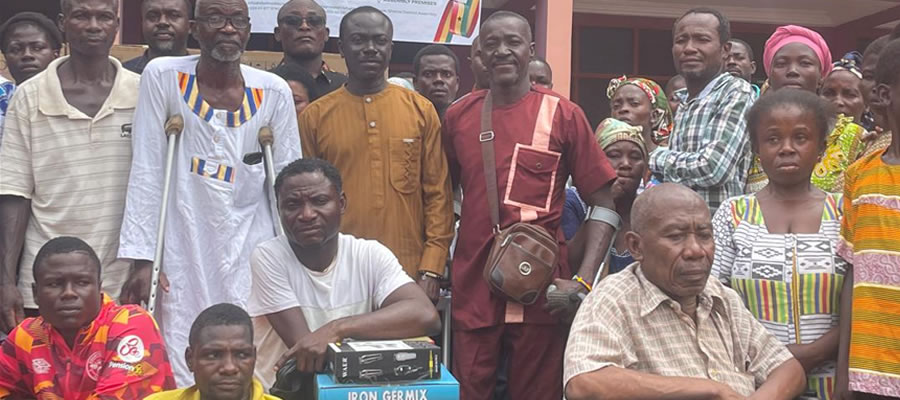

Main Source of Water for drinking and for other domestic use
Water sources are often classified as ‘improved’ or ‘unimproved’: Sources considered as improved are piped borne water into homes, public standpipe, borehole, protected (lined) dug well, protected spring, and rainwater collection. Unimproved are unprotected wells and springs, vendors, and tanker-trucks (WHO and UNICEF, 2000).
Table 8.10 shows the main source of water for households for drinking and other domestic purposes in the Shama District. A significant proportion of households have access to public tap/standpipe (44.3%) and pipe-borne water outside dwelling (34.2%), while a relative lower proportion (10.3%) use pipe-borne inside dwelling as their main source of water for drinking. The proportions of the population having access to pipe borne water indicate that Shama District is making progress towards the provision of potable water. Dugout/ponds/dams and canal (1%) is no longer a major source of water for households in the District.
There are no major variations in the sources of water for drinking in urban and rural communities except for households that access pipe-borne outside their dwelling. In the urban areas, 40.5 percent of households have access to pipe-borne outside their dwellings as their main source of water for drinking, while in the rural areas, the proportion is 26.3 percent. Also, households in urban areas in the Shama District, do not use unprotected wells as a source of water for drinking, however, 10.6 percent of households in rural communities use unprotected wells as source of drinking water.
In addition, pipe borne water outside dwelling (31.7%) and public tap/standpipe (43.0%) remain the main sources of water for other domestic uses in the District as shown in Table 8.10.
Bathing and Toilet Facilities
The type of facilities used by households as places of convenience and bathing are discussed in this section with the use of Table 8.11.
Toilet facilities
An efficient and hygienic method of human waste disposal available in a dwelling unit is a critical indicator of the sanitary condition of a unit under MDG 7. Table 8.11 and figure 8.3 show that, the main type of toilet facility used in the District is public toilet (46.6%) followed by pit latrine (11.2%), WC (9.6%) and KVIP (9.4%). A significant proportion (22.6%) of households in the District does not have toilet facilities.
The use of public toilets in the rural areas (48.7%) is higher than the patronage of public toilet in urban areas (44.9%). More urban households (12.1%) use the WC with 6.4 percent of rural households using the same facility. On the other hand, 17.4 percent of rural households use the pit latrine than 6.3 percent of households in urban areas. The proportion of households without toilet facilities (use of bush/beach and field as place of convenience) in urban areas (27.8%) is higher than rural households (16.0%). Bucket or pan toilet facility is the lowest (0.2%) facility patronized in the District.
Bathing facilities
Table 8.11 further shows that the main source of bathing facilities used by households is shared separate bathroom in the same house (25.1%), with others such as own bathroom for exclusive use (22.0%) and the use of shared open cubicle (21.2%). Households which use public bath house facility also constitute 12.0 percent. More urban households (29.5%) use shared separate bathroom in the same house than rural households (19.7%). Similarly, 17.8 percent of urban households use public bath houses, while proportion of rural households in this category is only 4.6 percent. Proportion of rural households (31.3%) using own bathroom for exclusive use for bathing is relatively higher than r urban households (14.7%).
Method of Waste Disposal
Despite the efforts of Zoom Lion Ghana Limited and other waste management companies, waste management remains a major challenge to the District and the country at large. Table 8.12 shows the means of waste disposal in the District.
Solid waste disposal
The main means of solid waste disposal in the District are public dump in open space (58.2%) and public dump in container (26.1%). Public dump (open space) in rural areas which constitutes 68 percent of the means of solid waste disposal is relatively higher than in urban areas (50.4%). Besides the two major means of waste disposal, 7.6 percent of households burned their solid waste, while the proportions are 9.7 percent and 5.9 percent in rural and urban areas respectively. More rural households (6.1%) than urban households (1.9%) dump their waste indiscriminately in the Shama District.
Liquid waste disposal
The disposal of liquid waste on the compound and in the gutter is quite predominant in the District with proportions of 30.1 percent and 30.0 percent respectively. The use of the sewerage system (2.0%) as a means of disposing liquid waste is very low in the District, with the proportion of urban areas (3.3 %) higher than the rural areas (0.3%).
Date Created : 6/27/2022 12:00:00 AM













 facebook
facebook
 twitter
twitter
 Youtube
Youtube
 +233 593 831 280
+233 593 831 280 0800 430 430
0800 430 430 GPS: GE-231-4383
GPS: GE-231-4383 info@ghanadistricts.com
info@ghanadistricts.com Box GP1044, Accra, Ghana
Box GP1044, Accra, Ghana